PWM/PID Motor Control using Orangutan from Pololu:
Hardware and Software
Tests
Jim Remington
This site was created to share some experiences with the nice little
Orangutan controller from Pololu corp.  The Pololu folks are great engineers but despite
enthusiastic promises of examples to come, they do not seem to be able to
provide software support for their products. They need help
from their users!
I'll be happy to post code/links/comments from others here. For example,
Cathy Saxton of Idle Loop Software Design has posted an extensive C++
code
example
for the Orangutan that is well worth studying. Here, I provide some
vanilla C examples.
The Pololu folks are great engineers but despite
enthusiastic promises of examples to come, they do not seem to be able to
provide software support for their products. They need help
from their users!
I'll be happy to post code/links/comments from others here. For example,
Cathy Saxton of Idle Loop Software Design has posted an extensive C++
code
example
for the Orangutan that is well worth studying. Here, I provide some
vanilla C examples.
The Orangutan is based on the ATmega8 controller from Atmel, which is
great because of the availability of excellent free development
software -- especially WinAVR. I use PIC processors when I can
because the instruction set and hardware is so simple, but usually
program them with MPLAB in assembler. PIC C compilers are expensive, and
not as flexible as the fine gcc compiler.
The down side is that the built-in hardware of the ATmega chips is
extremely flexible and the documentation is very hard to read. So, just
getting a simple pulse-width modulated motor controller working can be
difficult hard unless you have examples to follow. Read on:
The development system
I use a laptop running WinXP Pro
connected to the AVRISP programmer via a USB serial cable adapter. The USB
serial port ends up being different COMn ports depending on which USB port
it is plugged in to, so the makefile often has to be edited. The makefile
that I'm currently using is here. I have the Atmel
development software installed but I've only used it once for a medium-sized
assembly language project. C is certainly less work, but quirky and
less intimate.
Robot testbed
The test bed is a home-made minisumo rig controlled by the Orangutan. The
motor controller drives two standard servos, modified for
free rotation and from which the electronics have been removed. The entire
thing is powered by a single 6 volt alkaline battery pack. 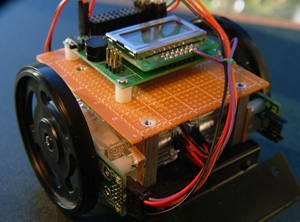
"WheelWatcher" modules (WW-01) from Nubotics,
attached to the servo bodies, were used to measure the wheel rpms.
The code examples provided by Nubotics were useful to figure out how to
use the modules, but the examples are very complex--far more complex than
they need to be to get the basic job done. I monitored only the right
wheel in my tests. The clock output of the WW-01 (purple lead) was
connected to INT0 (PORTD.2), which unfortunately is required as an output
to the Orangutan LCD module. An INT0 interrupt routine counts segment
ticks and measures the period of wheel rotation (time between segment
ticks), accumulating average values. The direction of wheel rotation and
total travel distance was monitored by the same routine, with the WW-01
direction bit (orange wire) connected to PORTC.5. The distance and
direction information were not used in my example, but could be used for
dead reckoning. This setup was later used to implement error-correcting
proportional (PID) speed control, as PWM alone is insufficient for robust
speed control. See below.
My opinion of the WheelWatcher? Glad you asked! A good idea, but
too expensive and too limited in mounting flexibility for different
motor/wheel configurations--I now have a spare set that won't fit my other
applications.
Also, if you make a mistake applying the black-and-silver reflective
wheel sticker, the replacement cost is outrageous -- $5.00 plus shipping
at one supplier.
The wheel speed is measured by computing the period between segment
ticks. Timer0 increments at 3.9 kHz and when it overflows, an interrupt
causes a counter to be incremented, extending the resolution to 24 bits.
As each wheel tick occurs, a time stamp is saved and used to compute the period
after the next tick. This approach fails when the wheel is stalled, so
a more complete routine (see PID code below) should include a timeout to
indicate zero velocity.
The LCD display on the Orangutan is good for accumulating the
information on the wheel rotational period as a function of the PWM
setting, but care has to be taken to disable the INT0 interrupt and
reinitialize the LCD output bit on PORTD, as they can't be used by the two
routines simultaneously. The actual test code, not cleaned up for
publication, is WW_pwm_test.c, which requires routines to run the
LCD display lcd_or.c (modified from an example
posted on the Polulo user forum) and one of the PWM modules mentioned
below. This
program steps through a series of PWM settings, measures the wheel
rotational period, and outputs the period and PWM setting on lines 1 and 2
of the LCD display, respectively. The wheel speed is calculated in
arbitrary units as 1/(period*0.256E-3)--see graphs below.
On board motor controller
The on-board LB1836M dual H-bridge has four modes of operation (taken
from the data sheet, available from Pololu, or here.)
| IN1/3 | IN2/4 | OUT1/3 | OUT2/4 |
Mode |
| H | L | H | L |
Forward |
| L | H | L | H | Reverse |
| H | H | L | L | Brake |
| L | L | Off | Off | Coast |
Forward and reverse modes are obvious, however the difference between
the "brake" and "coast" or output-off modes is less obvious. Brake mode is
in principle supposed to stop the motor quickly by acting as a short
circuit across the motor terminals, but the current must flow through one
of the output surge suppressor diodes as well as an output transistor,
depending on the direction of motor rotation. The forward voltage drop
across these components limits the effectiveness of the braking action
Conversely, in "output off" mode the outputs do not conduct current and
the motor coasts or freewheels. Either mode can be used for PWM control
but the results are quite different (see below).
Brake action is
power hungry
In brake mode, in order to hold the outputs low at the
rated collector current, base current must flow in the output transistors.
I measured this to be about 30 mA for each bridge (which is in agreement
with the chip documentation), so about 60 mA is wasted to hold the outputs
low if the motors are not rotating. A controller with FET output
transistors may be a better choice, but according to fearless leader ;)
Don Rumsfeld, you go to war with what you have. To save power, the motor
outputs should be turned off any time braking action is not needed. I have
not implemented this in my code, except for the case that speed=0.
PWM modes
The Timer1 module of the ATmega8 provides several PWM modes. I
experimented with two of these: 8-bit phase correct PWM (mode 1) and 8-bit
fast PWM (mode 5). There is no need to use more than 8 bits of speed
resolution. NOTE that the timer/counter1 registers are 16 bits wide, so in
8-bit PWM modes, take care to avoid setting speeds > +/- 255 or unexpected
results will occur. In either mode, timer/counter register TCNT1
increments at a set rate and the value is continuously compared to the
contents of registers OCR1A and OCR1B. When a match is reached, the bit
OC1A or OC1B is set or cleared according to the setting of the TCCR1A
control register and this action can cause a port bit, e.g. PB.1 or PB.2
to be set or cleared. In turn, PB.1, PB.2 and PD.5, PD.6 set the state
of the LB1836M motor controller, according to the above table. To avoid
confusion, in the code I've followed
the LB1836M documentation with regard to the definition of "forward" and
"reverse", but simply reversing the motor leads reverses these. There is
actually a good reason to do so, given the design of the Orangutan.
This is because the motor off-state during the PWM cycle can be either
braking or coasting, depending on the controller configuration, and the
two states do behave differently.
8-bit Phase Correct Mode
This mode is easy to use and does not require interrupt programming.
According to the ATmega8 documentation, this mode is preferred for motor
control, but I didn't see a difference compared to fast PWM mode except
for cycle time. In my implementation (see code pwm_8PC_direct.c), for forward motion,
OC1A=PB.1 is set high as TCNT1 increments, until match is reached with
OCR1A and then it is set low (likewise for PB.2). After TCNT1 reaches 255
(0xFF), it reverses direction and counts down until a match is again
reached, and PB.1 (PB.2) is set high again. Thus, the right motor is ON
until TCNT1=OCR1A and then it is off until TCNT1 counts down again to
rematch, whereupon it is turned on again, ad infinitum. The direction of
travel (and the nature of the "off" state) depends on the setting of PORTD
bits 5 and 6. In my code, forward motion alternates with "coast"
and reverse motion alternates with "brake" but this could be changed by
swapping motor leads and the speed variables. Forward PWM does not have
the same relation between speed and PWM (OCR1A/B) setting or motor current
draw as does reverse PWM, see below.
8-bit fast PWM
In this mode, TCNT1 counts from 0 to 0xFF and then overflows to 0. If
desired, an interrupt is generated when this overflow occurs. As in other
modes, TNCT1 is compared to OCR1A and OCR1B, and the bits OC1A and OC1B
are set or cleared on match. This can be used to provide PWM without
interrupts as in the above case, that is, PORTB bits 1 and 2 can be made
to change accordingly by the hardware. However, as in the previous
example, forward and reverse "off" modes are different. In order to get
around this, the bits OC1A and OC1B must be disconnected from PORTB and
the
appropriate actions are then taken by interrupt routines. In my
implementation, when TCNT1 overflows, the motors are turned on in the
appropriate direction, as determined by the global variables r_speed and
l_speed. When TCNT1 matches OCR1A or OCR1B, the right or left motor is
turned off, either in brake mode or coast mode, depending on which code
example is loaded. A special case occurs when l_speed or r_speed=0, in
which case the motor is never turned on. This avoids glitches in the
output.
In my implementation, three interrupt service routines are required
(TCNT1 Overflow, Compare matches TCNT1=OC1A and TCNT1=OC1B). The basic
routines pwm_brake.c and pwm_coast.c were written to implement this approach
and to study current draw and wheel rotational period (converted into
robot forward speed) as a function of the PWM settings. Hopefully this
example will be useful to others. Please feel free to offer corrections
or suggestions. The example driver program pwm_modetest.c can be used to call one of the
two PWM routines and exercise the motors.
If the foregoing is not completely clear, well, there is always the
ATmega8 chip documentation...
PWM mode tests
Although 255 motor speed steps are
permitted,
the gears are stiff enough that even when held off the ground, the wheels
on my test rig don't rotate until the PWM setting is about 35, and little
difference is seen for increments of 1 step. I chose to monitor free
rotation of the robot wheel, that is, the robot did not need to drag
itself around. Needless to say the LCD display is hard to read when
moving! Besides, everyone's robot will behave differently. I measured
the overall current draw of the entire robot (Orangutan plus motor
controller plus WheelWatcher) by a multimeter in series with the battery
leads. With the motors off in "coast mode" about 60 mA was
consumed. With
motors off in "brake mode" about 120 mA was consumed, due to ~60 mA
base current for the output transistors in the motor driver chip. Maximum
current draw for "free air" rotation (right wheel only) was around 250 mA
in brake mode PWM. The current draw is of course higher if the robot is running
on the ground.
For brake mode, the wheel speed is very linear with the PWM
setting but the current consumption is generally high and very nonlinear
with the PWM setting. Graphs of the results are posted below. As you can
see, the current draw is highest when the motor is running at about half
speed. This makes perfect sense: for half of the PWM cycle, the rotational
energy is being dissipated by the braking action. However, the speed
setting is quite robust, that is, low speed performance is good, and the
robot maintains its speed rather well if a bit of resistance is applied to
the wheel. Why this should be so is less obvious, and it is not true
for coast mode.
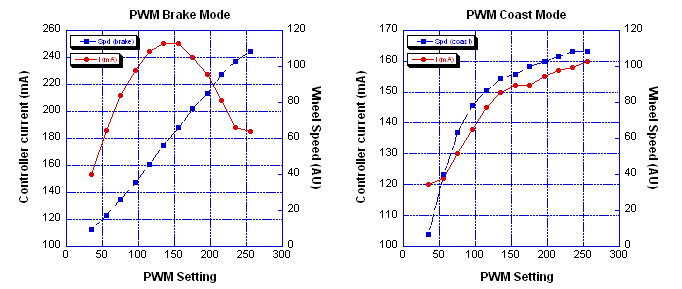 .
.
For coast mode, the wheel speed is a nonlinear function of the
PWM setting, and tops out at well below PWM setting=255. The current draw
at low to intermediate speeds is quite a bit lower than with brake mode,
but about the same when both are maxed. However, at intermediate
speeds, the wheel rotational rate is not
robust and slight resistance applied to the wheel causes it to slow down
rather quickly. In the graphs at right, wheel speed is in arbitrary units
(AU).
Note on CPU clock speeds
The Orangutan is shipped with the
default CPU clock speed of 1 MHz. At best this leads to a PWM cycle time
of 3.9 kHz for 8 bit resolution. Higher frequencies of 10-20 kHz are
said to be
advantageous. You can reprogram the ATmega8 fuses to use an 8
MHz internal clock, which I did using AVR Studio 3.56 (when selecting the
device
programmer, a window opens allowing you to change fuse settings). All
of the examples shown here work, given appropriate changes to the delay
loops. The power drain and speed tests described above are reported for 1
MHz cpu clock only.
Preliminary conclusions: brake versus coast mode
For simple PWM speed control, brake mode has better linearity of speed
versus PWM setting and speed is maintained reasonably well with changes in
wheel motion resistance. However, current draw is high. With coast mode,
current draw is much lower at intermediate speeds, but the speed is a
nonlinear function of the PWM setting. Also, the speed depends strongly on
resistance to wheel motion. However, if the speed is actively
controlled by a PID algorithm, "coast mode" should be
superior as the power draw is lower.
PID code
With the above code in place, it proved straightforward to implement a PD
(Proportional/Derivative) algorithm to control the wheel rotational speed
in the arbitrary range of [80,255]--at lower than 1/3 power, motor
operation was found to be unreliable. "Coast mode" PWM was used
to save power. Wheel rotation is monitored by the WheelWatcher modules,
although the only signal actually used is the segment tick. It would be
much
cheaper to use a phototransistor to peer through spokes or holes to get
that
signal. The basic program operation is as
follows:
- Main program posts speed request and sets an approximate PWM
setting via the function call set_speed(left, right)
- Ticks from WheelWatcher activate an interrupt that measures the
current period, converts to velocity and applies the PD algorithm.
- The PWM module is controlled by the PD algorithm, which modulates the
motor power.
- A Timer0 interrupt provides a basic clock tick that, among other
tasks, counts down a separate timer for each wheel to detect a stall. If
this happens, the PWM on time for that wheel is bumped up.
The algorithm is proportional/differential (PD) with an
additional low-pass filter. I found it was not necessary to include an
integral term.
- Wheel rotational period is determined from the WheelWatcher
ticks.
- Period is low-pass filtered via per = 0.25*per + 0.75*last_per
- speed = constant/per. Constant is chosen so that max speed=255
- error = (requested_speed - current_speed)
- delta PWM = Kp*error + Kd*(error - last_error).
The PD code
Works great! Take a look at the
all-in-one example pid_kd_all.c.
Tuning the code
Tuning means to determine the mysterious constants Kp and Kd, which in
turn will depend on the system: motor gear ratio, battery voltage, overall
weight, friction, phase of moon, etc. There are entire web sites (plus
thick, four-color, expensive, dense & excruciatingly boring undergraduate
engineering texts) devoted to the process. Sadly, no standard notation
seems to have arisen, not even the sign of the error term seems to be
standard! It is easiest to start with floating point calculations and
then convert to integer math for speed. You will probably need 8 MHz
CPU
clock or higher.
The basic operation of
tuning is fairly simple: you begin with small Kp and Kd=0, and increase
Kp until first the system response (e.g. motor speed) stabilizes, then
further increase Kp until the response starts to oscillate. Back off Kp
a bit, then, increase
Kd in order to damp down the oscillations. In theory, there should at most
one overshoot in response to a step change in speed.
For more detail, one place to start is the WikiPedia entry.
However, Parallax Inc. has a great example of PID process control using
the Basic Stamp.
Finally, there is always Jeff Bachiochi's lovely example of magnetic
levitation in Circuit Cellar
(Issue 18, Dec-Jan 90-91), in which only 15 lines of BASIC code were
required to levitate a steel sphere with an electromagnet. For another
amusing example, see the PID-Pong levitating ping-pong ball challenge by
Tom Cantrell in issue #50 of the same publication.
To facilitate tuning, you should have a means of studying the
operation of
the algorithm at fairly high speed. Following an example C program posted
by
Nubotics,
I used high speed RS232 output
(38400 baud) using the built-in UART to capture the action of the PD
algorithm at 0.1 second intervals on a PC. All that is needed is a time
stamp, the
current speed and PWM settings, which is all the main loop of the test
program does after posting a requested speed. The output was captured by
HyperTerm and loaded into a spreadsheet for plotting. I found that
the values for Kp and Kd were not critical, with Kp in the range of 0.1 to
0.2 while Kd needed to be about 0.4 to 0.6. After an evening of
experimentation, I settled on Kp=0.15 and Kd=0.40. See the plots below for
some examples, with comments.
The graphs below show the speed and
PWM setting for about 30
seconds. The horizontal axis is clock ticks.
Note:I
physically grabbed
the wheel at two points during each test (for a few seconds) to slow it
down or stop it, so that I could observe the response.
Kp=0.1, Kd=0.0, note drift of speed about
setpoint--too little feedback
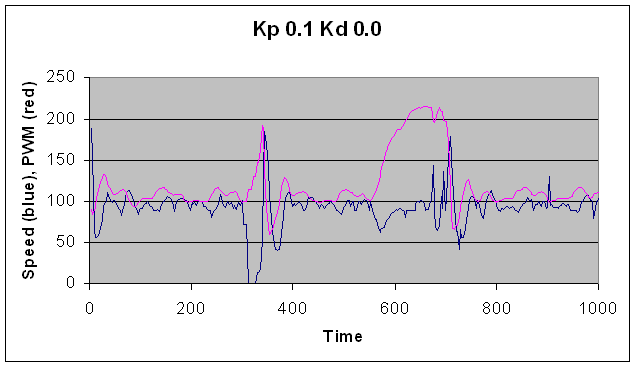
Kp=0.20, Kd=0.0, note violent oscillation of speed about
setpoint,
too much feedback
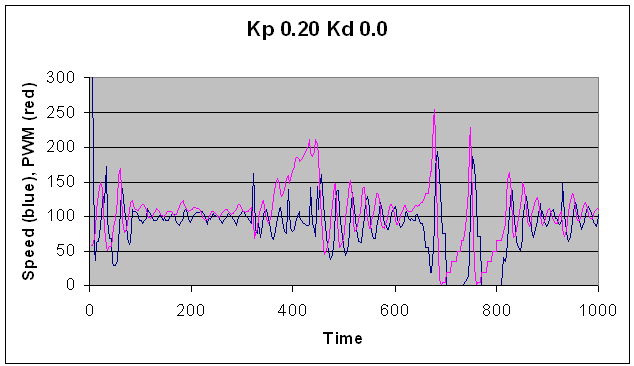
Kp=0.20, Kd=0.80. The violent oscillations are mostly damped
by
the error term, but the response is still jerky with large overshoots
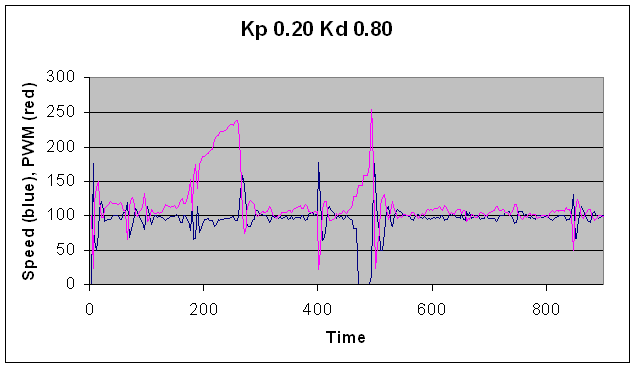
Kp=0.15, Kd=0.40. Good enough--one overshoot is fine! (The regular
oscillations in speed
are due to slightly sticky gears)
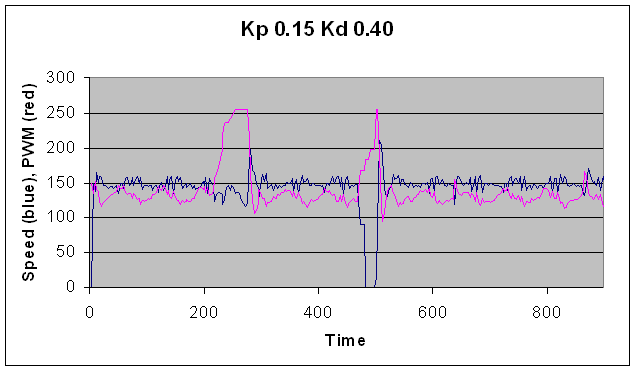
RS232 interface
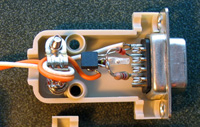
The RS232 AVR to PC transmit-only interface is port-powered from the PC
DTR, pin 4 (or RTS, pin 7) and it worked well at 38400 baud using a USB
to serial adapter.
Similar designs can be found in many places on the web, see for example
the
PICList
site. A schematic diagram is available here.
The diode is probably necessary as on my adapter, the RTS and DTR pins
swing from about +8V when
the port
is open to -8V when the port is closed, which could damage the transistor.
I built the circuitry into a D9 subminiature shell as shown above.
Feel free to
email
me with comments, questions or suggestions.
last update: 10/1/2006
Copyright
(C) 2006 by S. James
Remington. All rights reserved.
 The Pololu folks are great engineers but despite
enthusiastic promises of examples to come, they do not seem to be able to
provide software support for their products. They need help
from their users!
I'll be happy to post code/links/comments from others here. For example,
Cathy Saxton of Idle Loop Software Design has posted an extensive C++
code
example
for the Orangutan that is well worth studying. Here, I provide some
vanilla C examples.
The Pololu folks are great engineers but despite
enthusiastic promises of examples to come, they do not seem to be able to
provide software support for their products. They need help
from their users!
I'll be happy to post code/links/comments from others here. For example,
Cathy Saxton of Idle Loop Software Design has posted an extensive C++
code
example
for the Orangutan that is well worth studying. Here, I provide some
vanilla C examples.

 .
.




